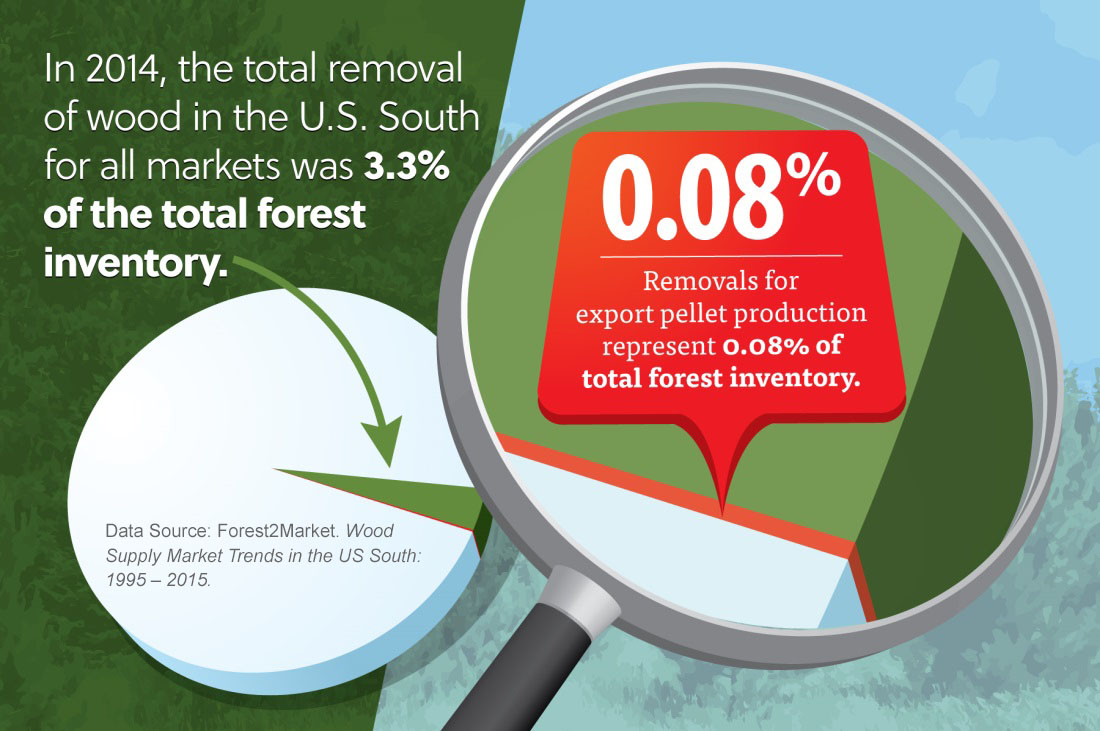2 min read
Forest2Market Study Shows U.S. Wood Pellet Industry No Threat to U.S. South Forests
Forest2Market
:
November 18, 2015

The U.S. export of industrial wood pellets to meet renewable energy goals in the European Union is not a threat to the sustainability of U.S. Southern forests, according to a new report by independent forest analysts and economists at Forest2Market using U.S. government and marketplace data. The report was commissioned by the U.S. Endowment for Forestry and Communities, National Alliance of Forest Owners (NAFO) and the U.S. Industrial Pellet Association (USIPA).
“This report puts to rest concerns that wood pellet export markets pose threats to the sustainability of U.S. Southern forests or the viability of other forest products manufacturers,” said Carlton Owen, President and CEO, U.S. Endowment for Forestry and Communities. “Markets are vital to keeping working forests as forests. At the Endowment we are committed to retaining our nation’s rich forest cover for the full range of ecological benefits they provide from clean water to recreational opportunities while at the same time supporting family-wage jobs that communities so desperately need. Whether those jobs are from traditional lumber and paper products or from renewable energy options such as those provided by wood pellets, each is vitally important to America’s heavily challenged rural communities.”
The report reveals that industrial pellet exports represent a very small part of forest harvests in the U.S. South and will continue to do so into the future.
- Total removal of wood in the U.S. South for all markets is 3.3% of the total forest inventory.
- Pellet exports represent 0.08% of the total inventory.
- In 2014, pine removals for industrial pellet production totaled 3.7 million tons or 0.3% of the pine pulpwood inventory and 0.09% of the total pine inventory.
- In 2014, hardwood removals for industrial pellet production totaled approximately 2.4 million tons or 0.2% of the hardwood pulpwood and 0.06% of the total hardwood inventory.
- In 2014, pellet exports from the U.S. South to Europe, which represent the vast majority of U.S. pellet exports, were 3.6 million metric tons, or 40% of Europe’s 9 million metric ton industrial pellet consumption.
- Future industrial demand for U.S. pellets overseas represents 0.3% of total forest inventory in the U.S. South.
- Realistic demand and market share outlooks show that U.S. industrial exports of biomass pellets to Europe could eventually rise to 10.8 million metric tons.
- Annual removals to meet this demand would total 25 million tons, which represents 1.0% of pulpwood inventory and 0.3% of total forest inventory in the South.
“The value society has placed on goods and services from our forests is the reason the volume of growing trees in our forests has increased by 50% since the early 1950s. The strong, positive relationship between markets and tree growth is why our forests remove 13% of our nation’s carbon emissions from the air each year,” said Dave Tenny, NAFO President and CEO. “This report should put any concerns about the fate of our Southern forests to rest and allow landowners to continue doing what they do best – stewarding our forests to provide forest products and renewable energy while contributing to cleaner air and water and more abundant wildlife habitat.”
“This study demonstrates in an independent, data driven manner that the industrial wood pellet industry is using an extremely small portion of the available inventory of sustainable low grade wood fiber in the U.S. Southeast,” said Seth Ginther, Executive Director, U.S. Industrial Pellet Association.
“It also demonstrates that the industrial wood pellet industry is taking the lowest value sustainable wood fiber for use as feedstock and that the industry is a complement to some of the more traditional forest product industries. Accordingly we hope that it will be helpful to policy makers when considering the positive role the industry can play in supplying secure, sustainable base load renewable power to the grid in Europe – which ultimately will enable Europe to meet its renewable energy goals.”
Read the full report, Wood Supply Market Trends in the US South: 1995 – 2015.




